Rating index:
Extraordinary (96-100)
Outstanding (93-95)
Very good to Excellent (89-92)
Above average to Good (86-88)
Below Average to Average (80-85)
Avoid (below 80)
More info >
Extraordinary (96-100)
Outstanding (93-95)
Very good to Excellent (89-92)
Above average to Good (86-88)
Below Average to Average (80-85)
Avoid (below 80)
More info >
The term "farm to table" or the relatively new "farm to fork" has become a marketing term used for almost any restaurant with a vegetable patch or restaurants that buy local produce. I don't know exactly when this term was coined, although the New York Times already mentions a "farm to table plan" in a 1914 article. Marketing term aside, for me farm-to-table is primarily a movement of restaurants who care about where their produce comes from, who source produce that's locally grown (rather than flown in from Kenia or Peru), who know their producers, and who, equally importantly, contribute to the local community. Obviously the movement means so much more than that for consumers in general, but here I focus on the restaurant side of the movement.
The primal force behind this movement were chef Alice Waters and her restaurant Chez Panisse in Berkeley, California, which opened its doors in 1971, a pioneering and influential restaurant that has gained national and international recognition. Some of Chez Panisse's famous alumni are Michael Tusk of 3-star restaurant Quince in San Francisco, Michel Troisgros of 3-star Maison Troisgros in Roanne, France, and Dan Barber, who interned at Chez Panisse in 1994. Ten years later he would open Blue Hill at Stone Barns in Pocantico Hills, upstate New York.
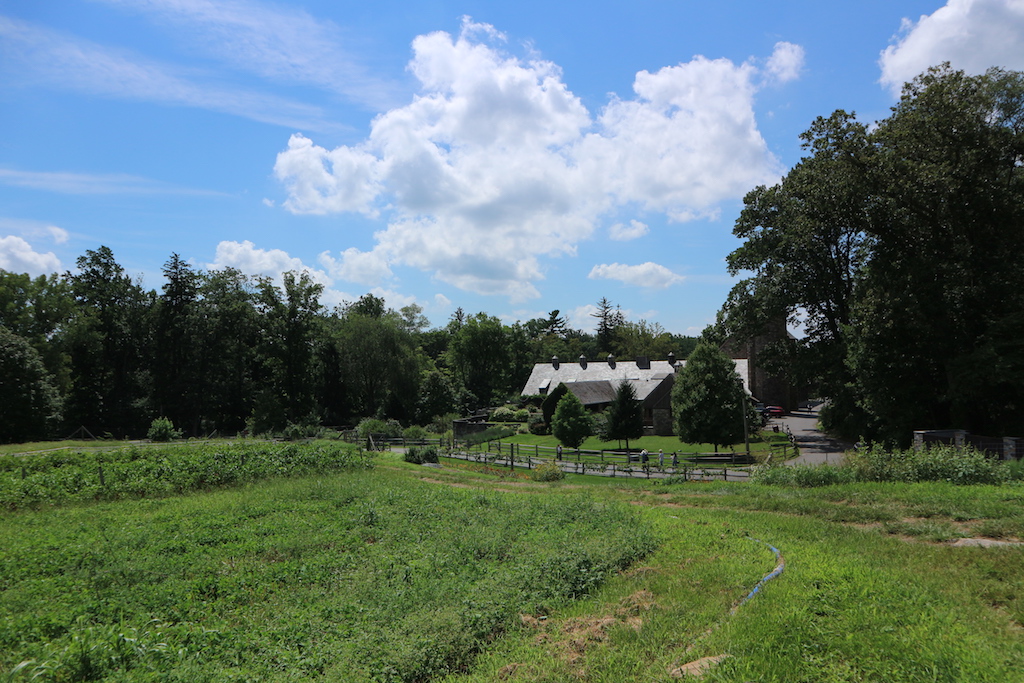
After his internship at Chez Panisse, Barber graduated from the French Culinary Institute in New York in 1994. He then moved to France where he worked in the kitchen of chef Michel Rostang in Paris (two Michelin stars), among others. Back in New York, Dan Barber worked for David Bouley at his eponymous restaurant Bouley in TriBeCa and later on he became executive chef at La Cigale in Manhattan. Around the same time he started a part-time catering business with his brother David in Greenwich Village, in a space that in 2000 would become his first restaurant (and the original Blue Hill). Dan Barber's second restaurant Blue Hill at Stone Borns in Pocantico Hills is a 45 minute journey from New York City and is situated on the 32 hectare, agricultural and educational facility Stone Barns Center for Food and Agriculture, originally part of the Rockefeller's 1,380 hectare Pocantico Hills estate. The Rockefeller family, and more specifically David Rockefeller, grandson of the oil magnate John D. Rockefeller, donated the grounds and funded a working farm and the renovation of the barns that would house the educational center. The Stone Barns complex was opened by David Rockefeller and his daugher Peggy Dulany in 2004.
Apart from his restaurants, Dan Barber (b. 1969) is a prominent and unique advocate of the farm-to-table movement. In his case this goes way beyond sourcing organic produce or having good relationships with his individual producers. Barber is also well known for having written "The Third Plate", a book in which he expounds his vision for the future of the human food chain, from farmers to chefs. More recent fame came when Barber featured in the first season of the popular Netflix series Chef's Table.
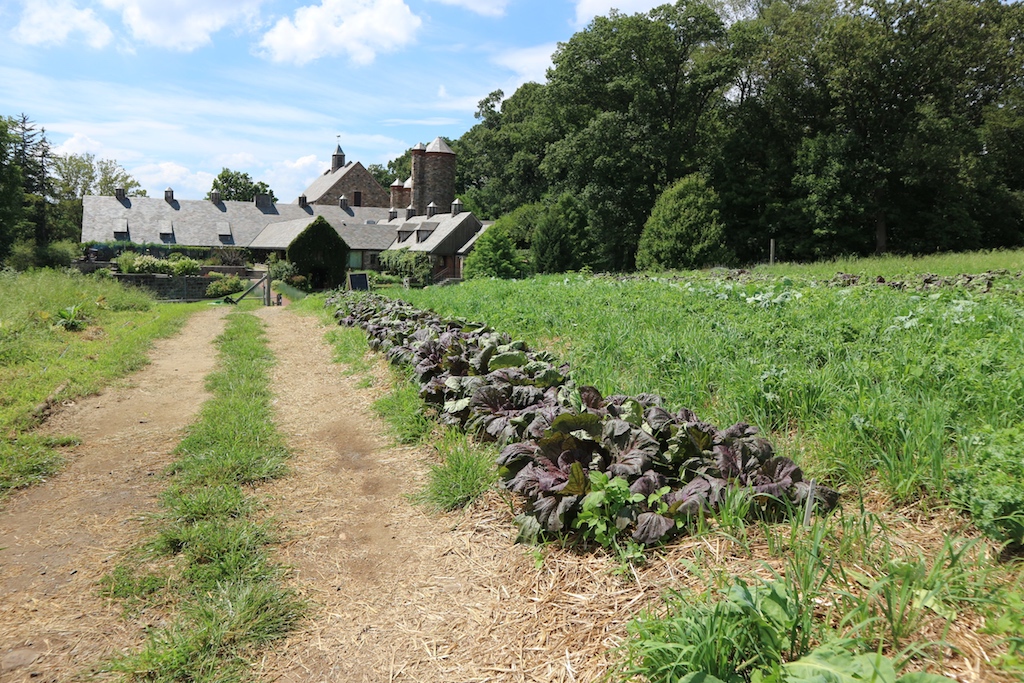
Blue Hill at Stone Barns is open for dinner Wednesday through Saturday and for lunch and dinner on Sundays. In the dining room the restaurant offers one, multi-course, seasonal tasting menu called "Grazing, Pecking, Rooting" priced at $238, excluding tax and tip. Another option is a counter seat at the bar, where they offer a tasting menu for $188, excluding tax and tip. Bookings can only be made online. I had lunch with my husband at Blue Hill at Stone Barns on Sunday 21 August 2016. *I made the booking directly with one of the restaurant's members of staff, so the restaurant knew I was coming and before the meal I was given a private tour of the grounds/farm by general manager Philippe Gouze. I paid my bill in full.
So, here we go.
First to arrive was Blue Hill's baby vegetable tasting with a great selection of sweet summer vegetables (baby red peppers, physalis fruit, yellow cherry tomatoes), and two more savoury summer snacks, a fresh baby courgette flower, and a lettuce leaf, both lightly salted and the latter also seasoned with a drop of lemon juice. This was quickly followed by a delicious pairing of crunchy and slightly radishy young kohlrabi with a nasturtium and blueberry puree dip, a very tasty fennel stalk grown on soil with zucchini compost, and finally some semi-dried peaches served with a mildly sharp peach compote and poppy seeds (sprinkled straight from the pod), the peaches having a wonderful floral sweetness to them.
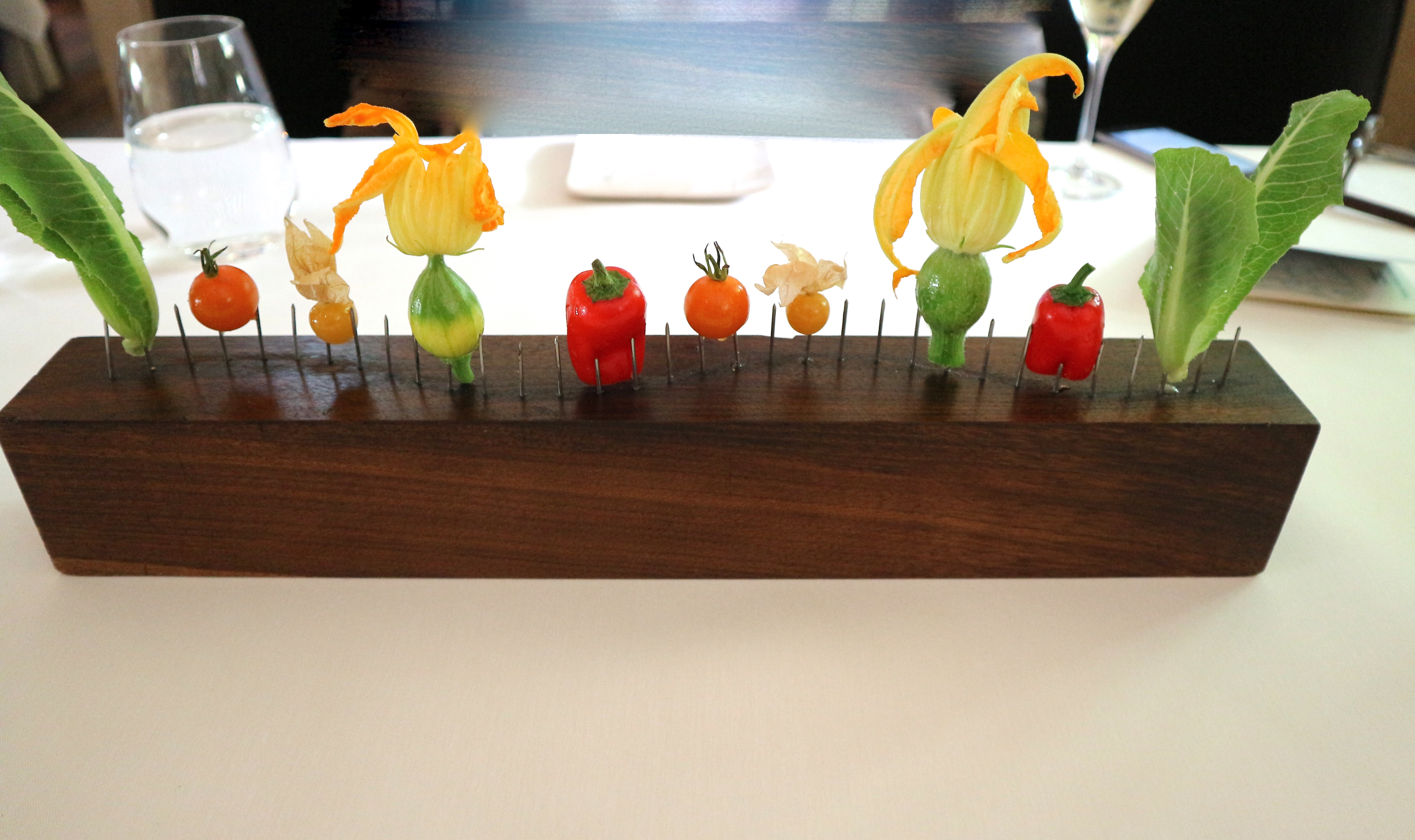
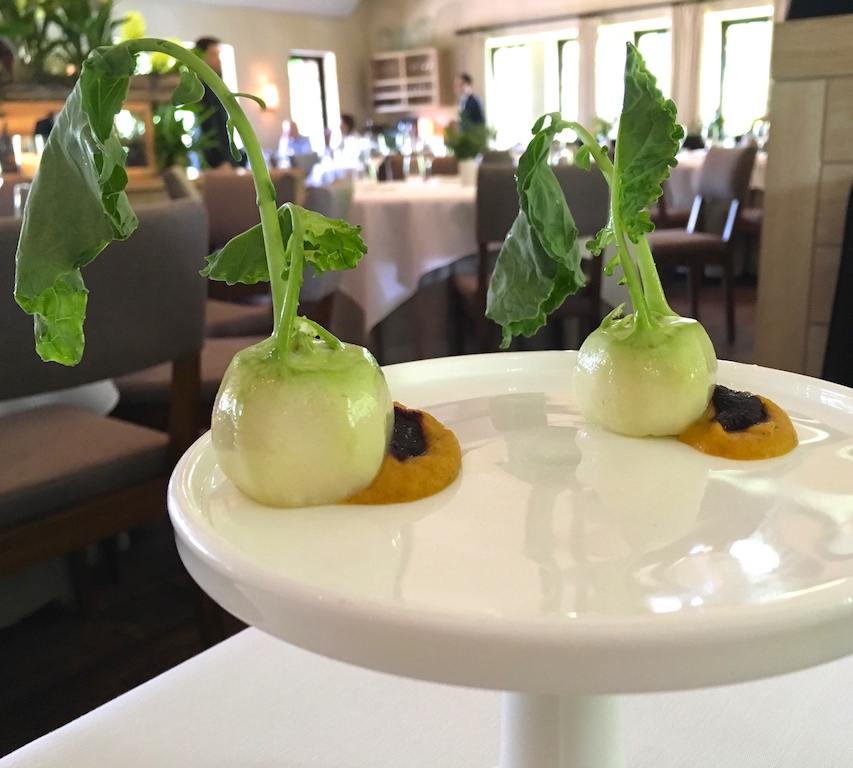

More snacks followed. There was summer squash, cut and served in an apple slicer, and served with a honey, salt, and sunflower powder/dip, which had an almost peanut-like flavour, and the flesh and skin of the squash were firm but tender. Homemade fennel sausage was served with fermented cucumber, lillies came in a delicate and crisp tempura batter, and there were crisp bacon wafers. Next, we were poured a glass of corn cob lemonade. The lemonade is made from leftover corn cobs and lemon peel, flavoured with lemon juice, lemon thyme and lemon cress. A nice and refreshing drink with lovely mild and sweet corn flavours. I believe this lemonade and the skate wing cartilage crisps that followed, originate from the 2015 pop-up WastED.
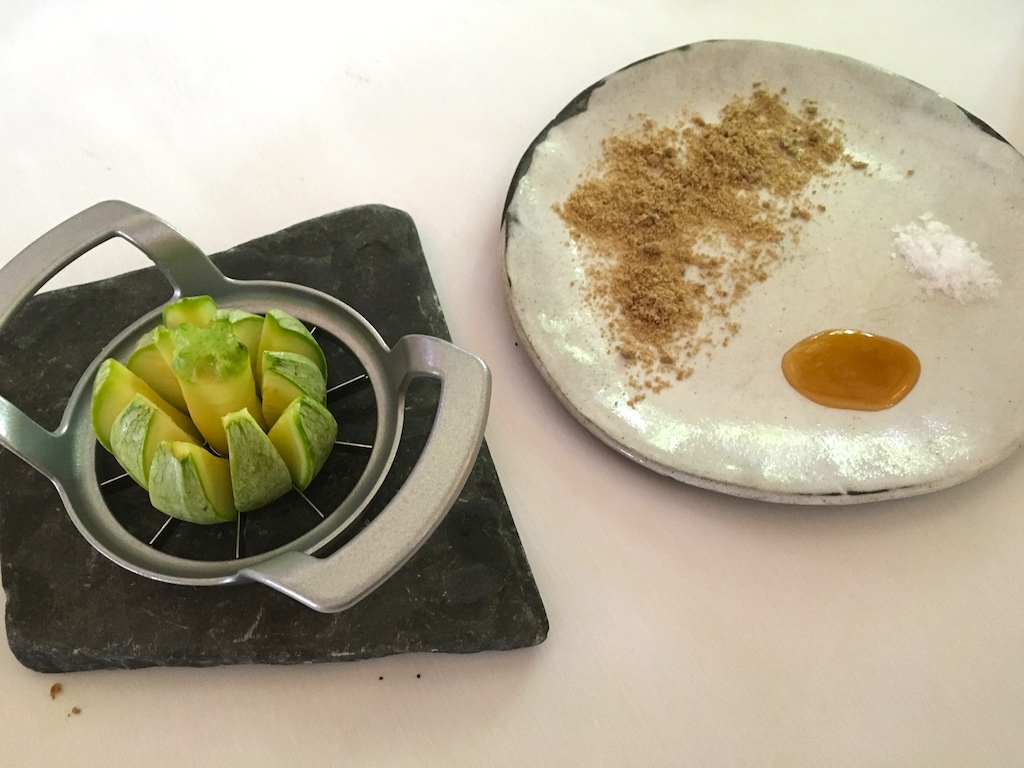
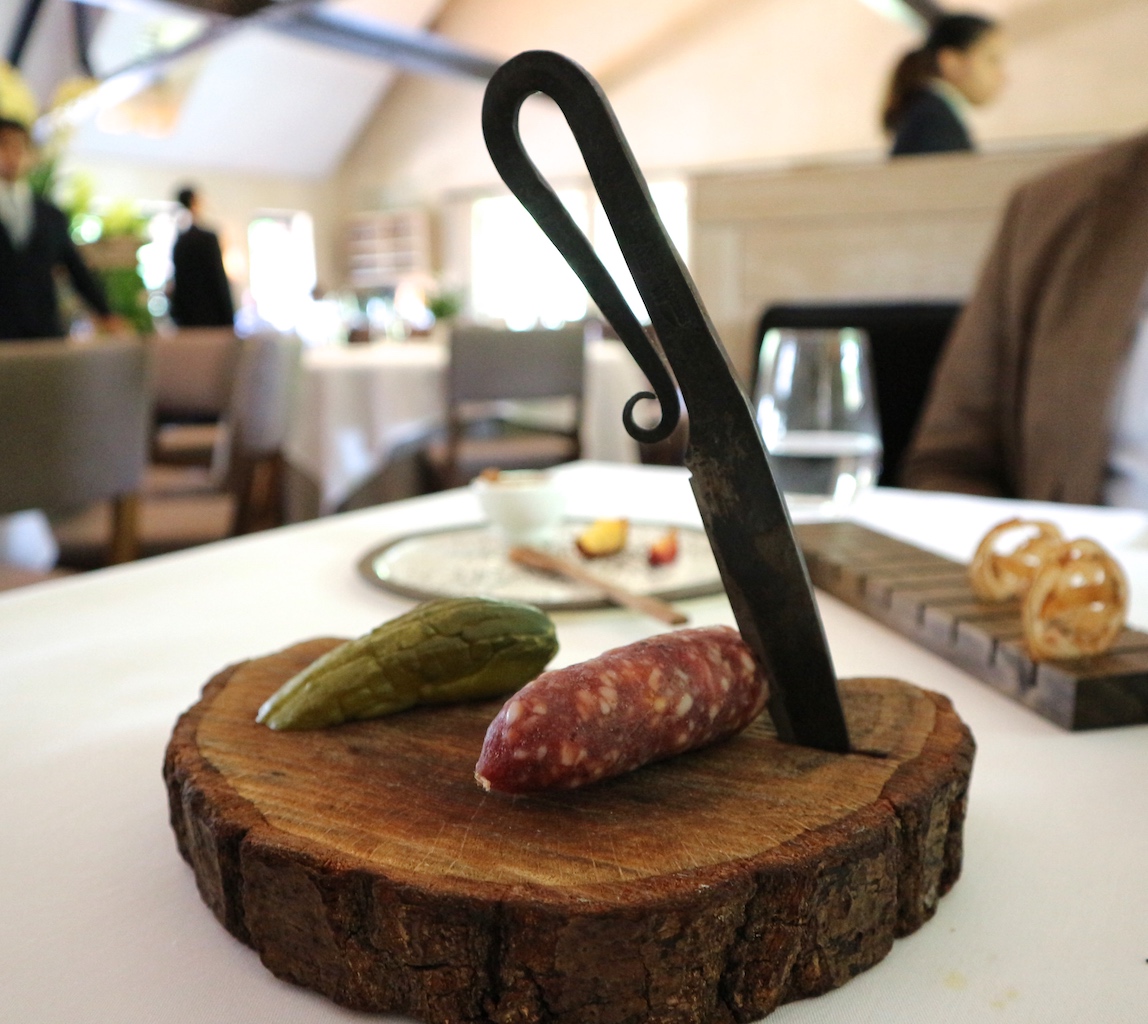
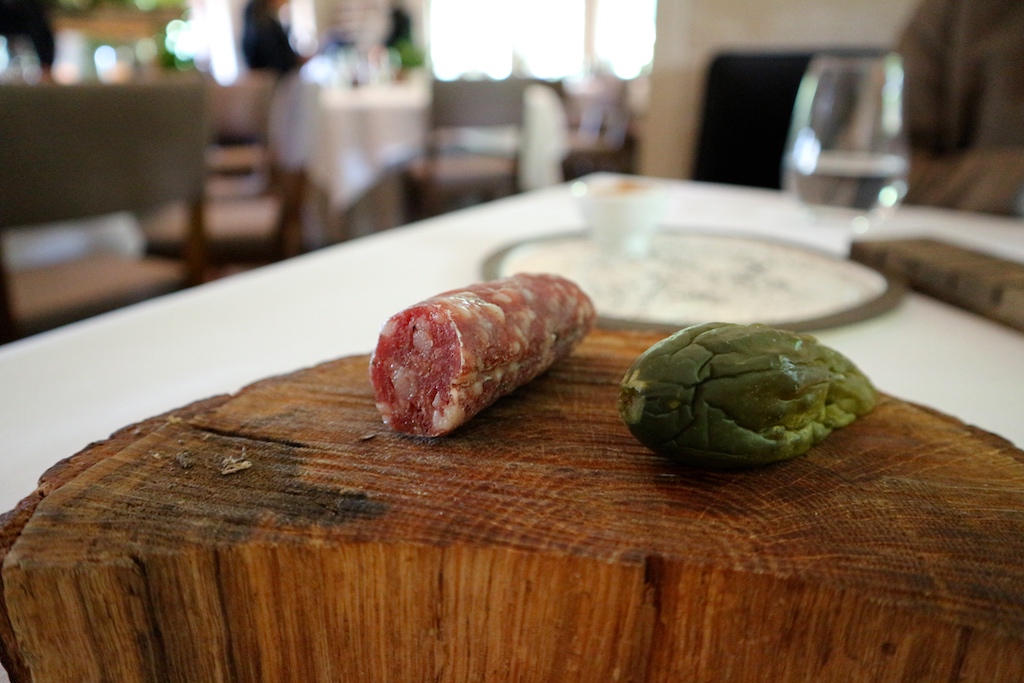
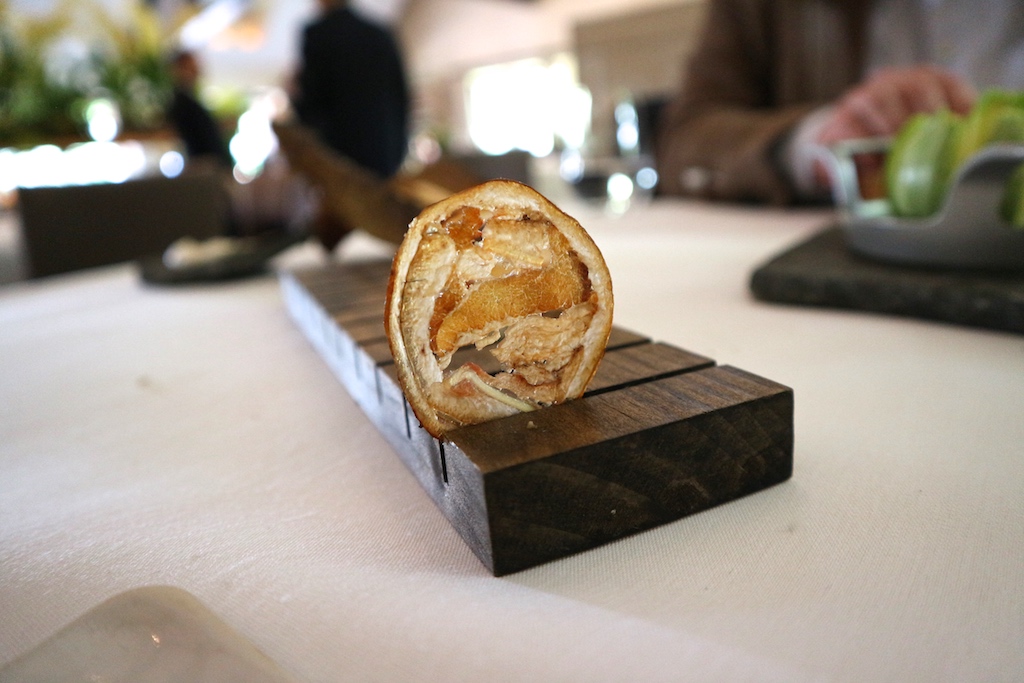
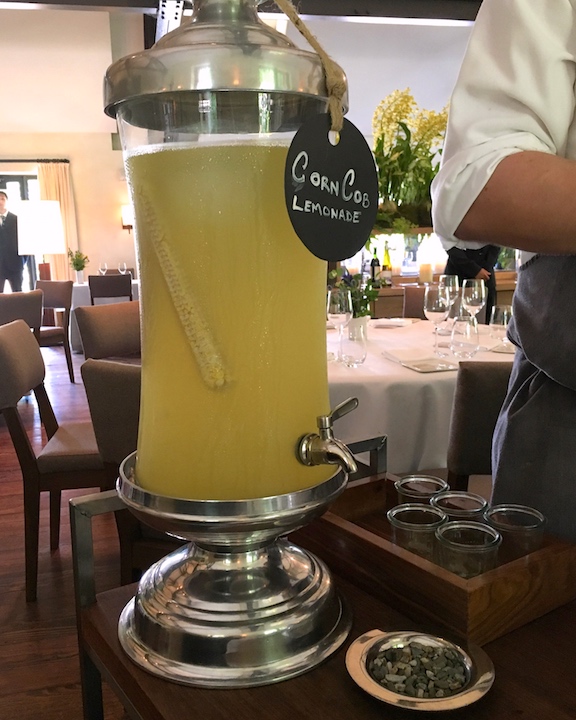
Shortly after, some skate wing cartilage crisps arrived, served with a smoked fish crème, a lovely combination and a clever use of fish leftovers. Some à-la-minute foraging was required for the next two bites. Crisp cheese "needles" were hidden in a small "haystack" and mini tartlets were covered with twigs and leaves. The tartlets had a filling of chanterelle mushroom puree, pickled blueberries and white raspberry. A wonderful filling with lovely contrasting flavours. Even better was the "beet pizza", with three types of thinly sliced and well-seasoned beetroot and shallots, served on a crisp and peppery base with sesame seeds.
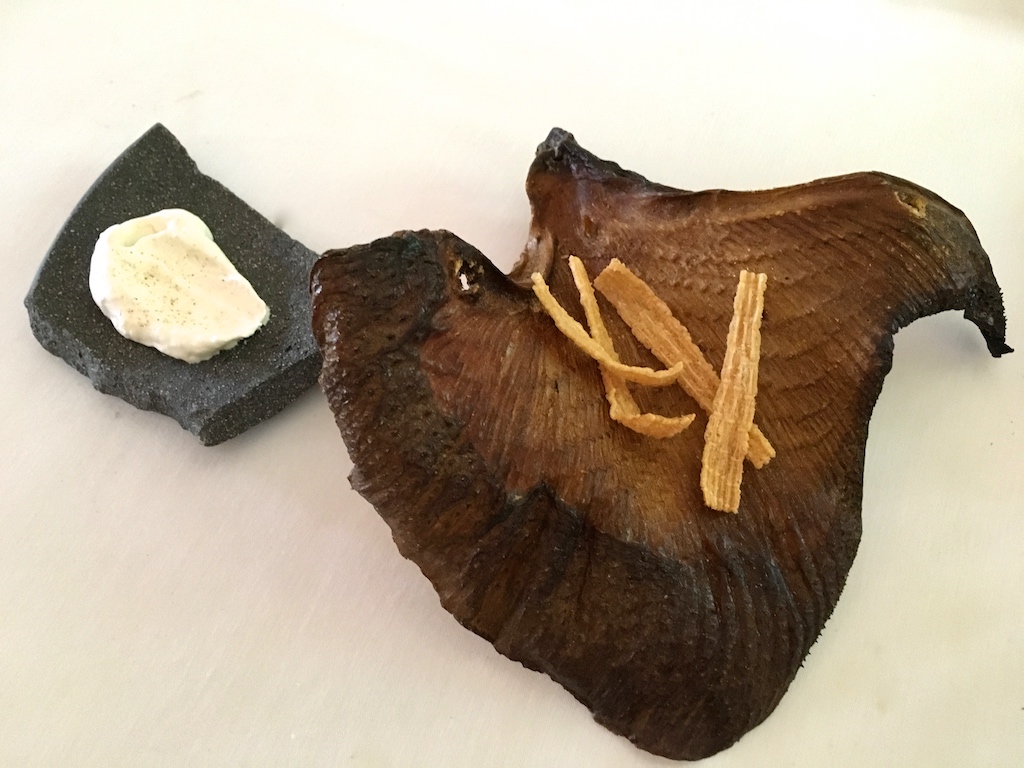

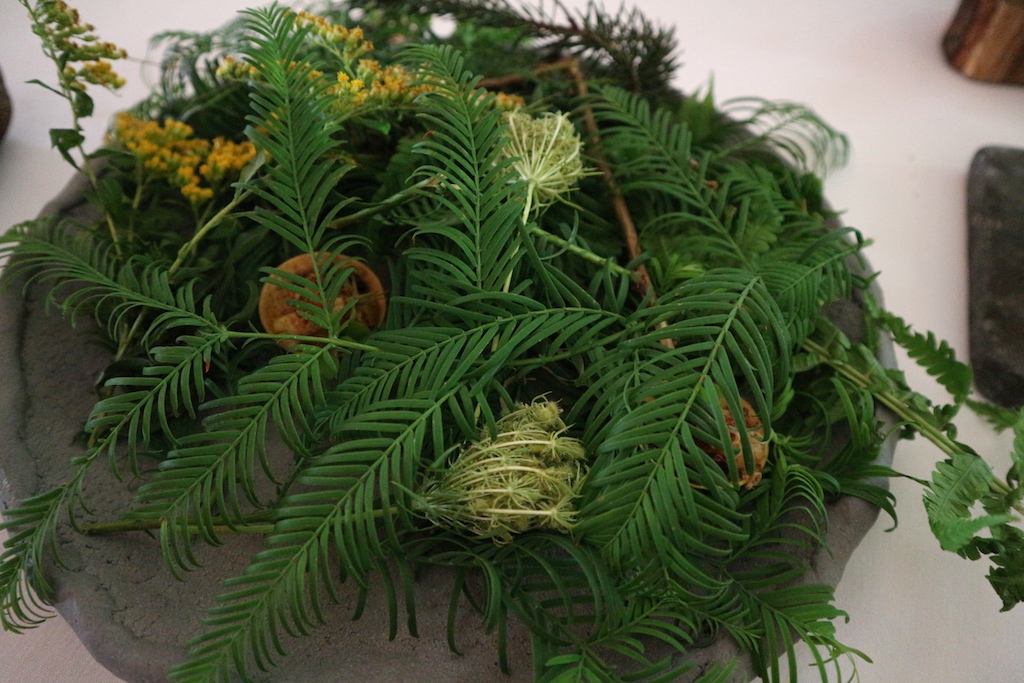
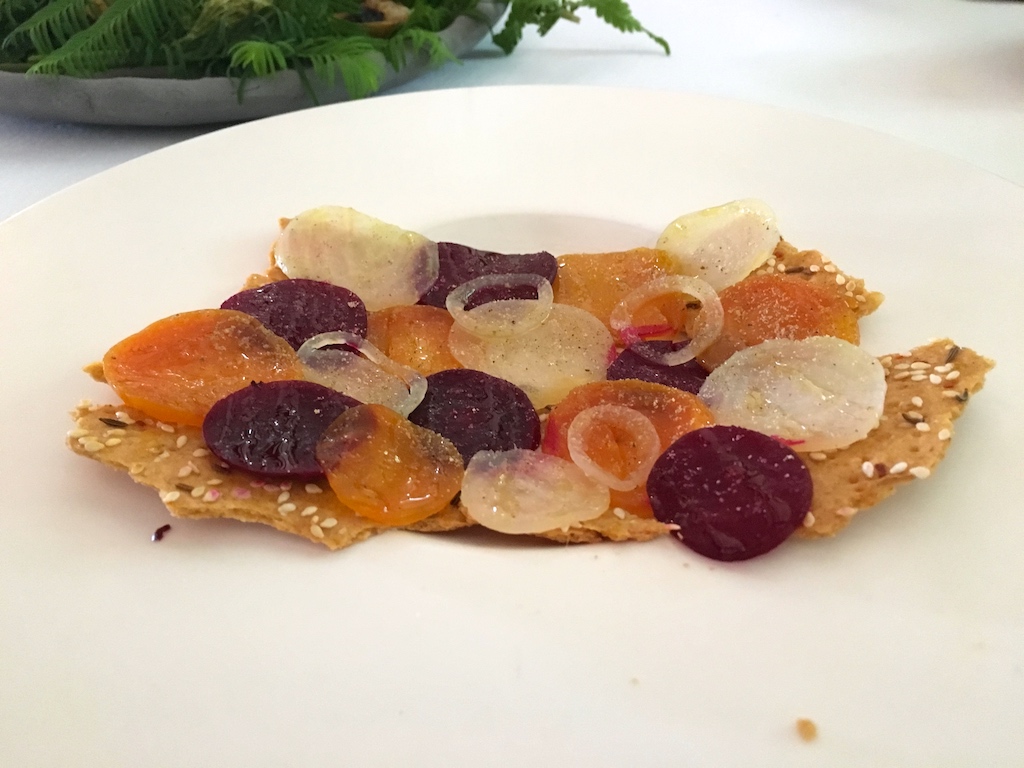
The last few snacks were charcoal cucumber tempura rings, "pig popcorn" (puffed pork skin), a magnificent sandwich of pig's liver paté and chocolate tuiles, and pig's heart pastrami and fermented watermelon rind, the former having a lovely herby finish, and the melon being nice and spicy.
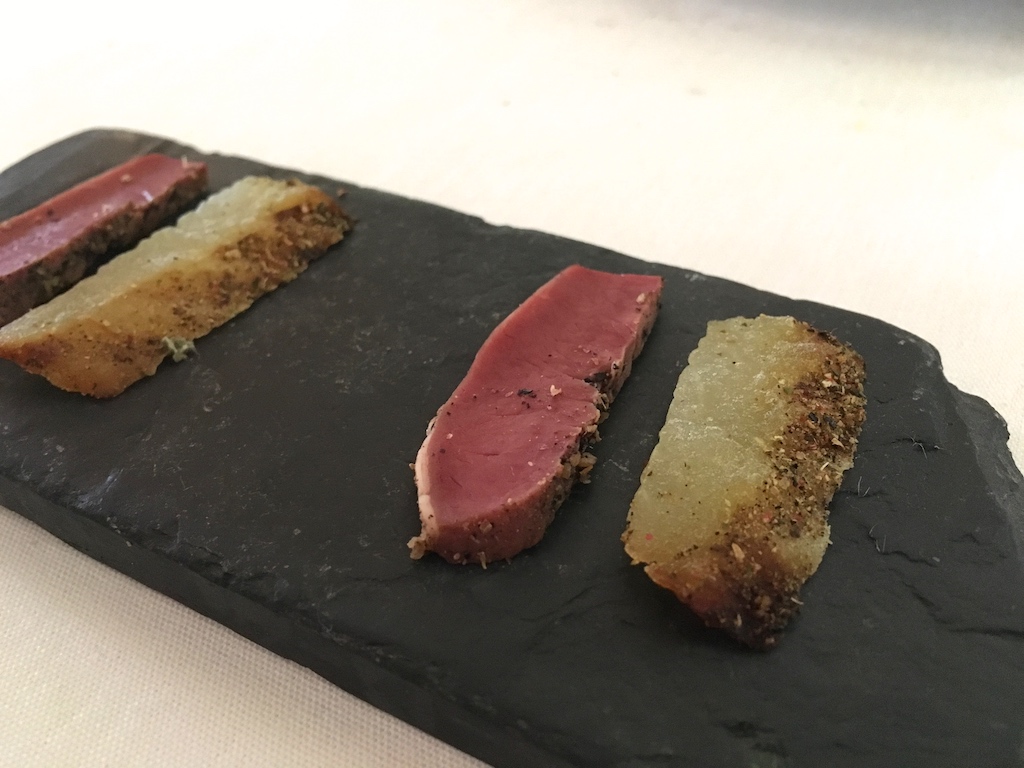
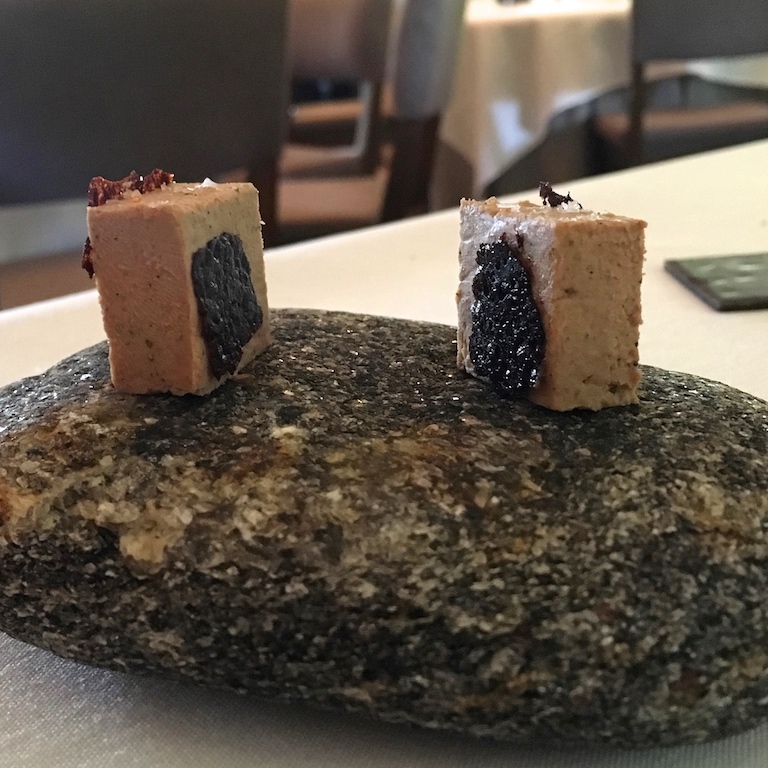
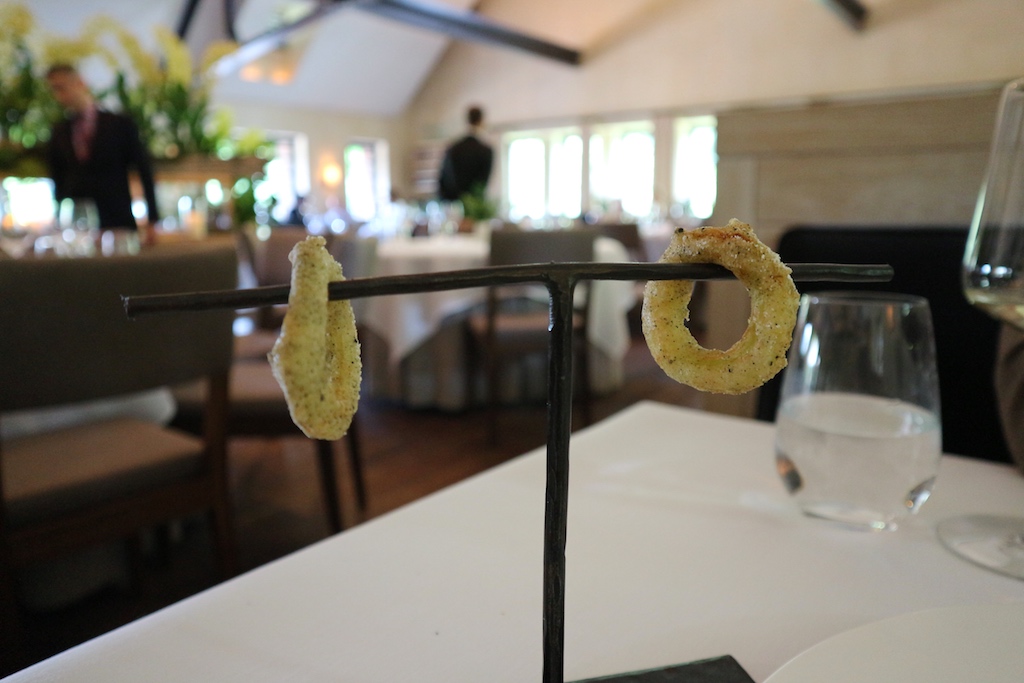
These snacks (around 17 of them) made for a fantastic and exhilarating start of this meal. I'm slightly uncomfortable using the word "snack" here, because this word certainly doesn't do them justice; first and foremost this was an impressive parade of inspired food.
A series of more substantial dishes followed. To start there was a green "cucurbitaceae family" gazpacho (think: courgette, cucumber, squash), served in a cup coated with yoghurt "snow". An excellent, well-made gazpacho, with a good sharpness, lovely and pure vegetal flavours, and with a lovely touch of summer sweetness coming through.
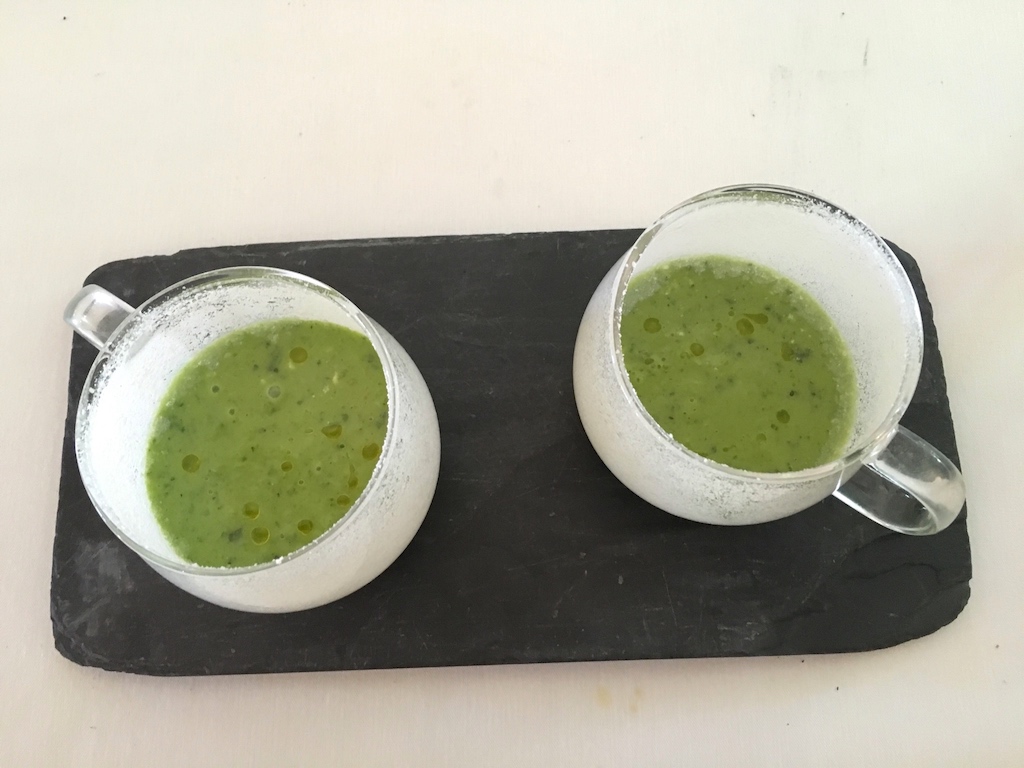
Next up were two preparations of tomato, one hot, one cold. A warm and beefy tomato, seasoned with a touch of paprika, was served with a roasted tomato marmalade, some pesto oil, and a drizzle of soothing smoked goat's cheese. A very pleasing and pure-tasting combination with a wonderful hint of umami richness. The cold preparation was an heirloom tomato salad, well-seasoned with salt, and perfectly paired with basil oil, sweet basil seeds, thinly sliced melon, a few drops of balsamic vinegar and some strained yoghurt. A beautiful interplay of mildly sweet and vegetal flavours, and the basil seeds and balsamic vinegar provided just the right touch of sweetness. Alongside this, we were served some incredibly sweet, almost caramelly melon with melon "tears" (strained melon juices).
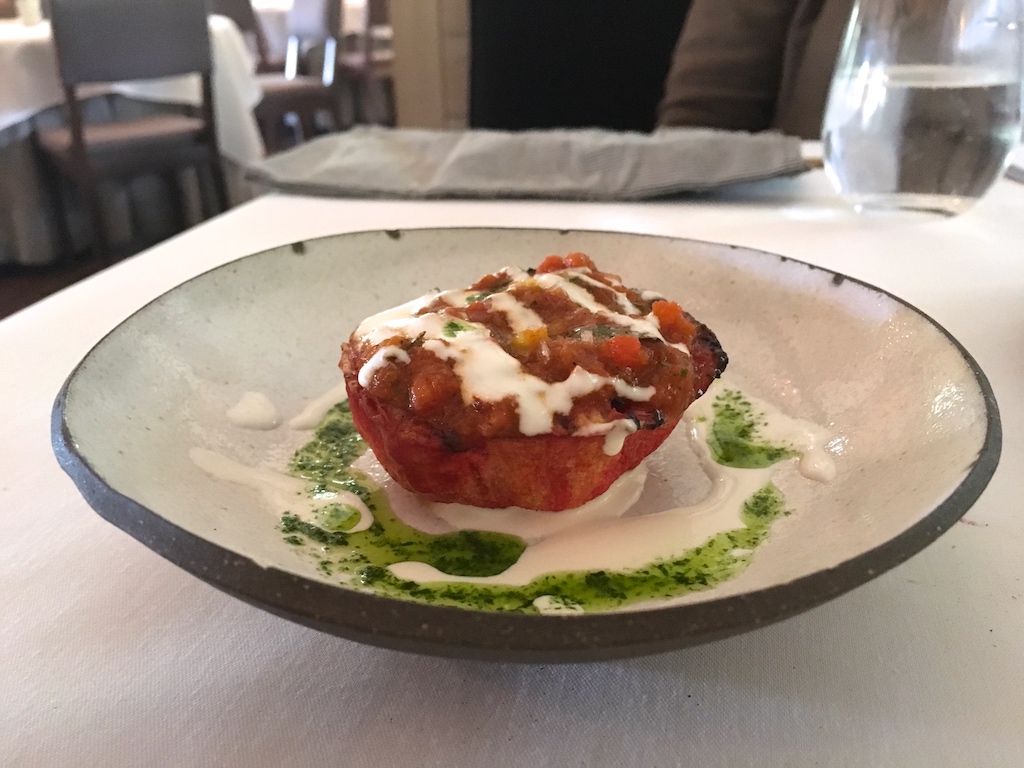
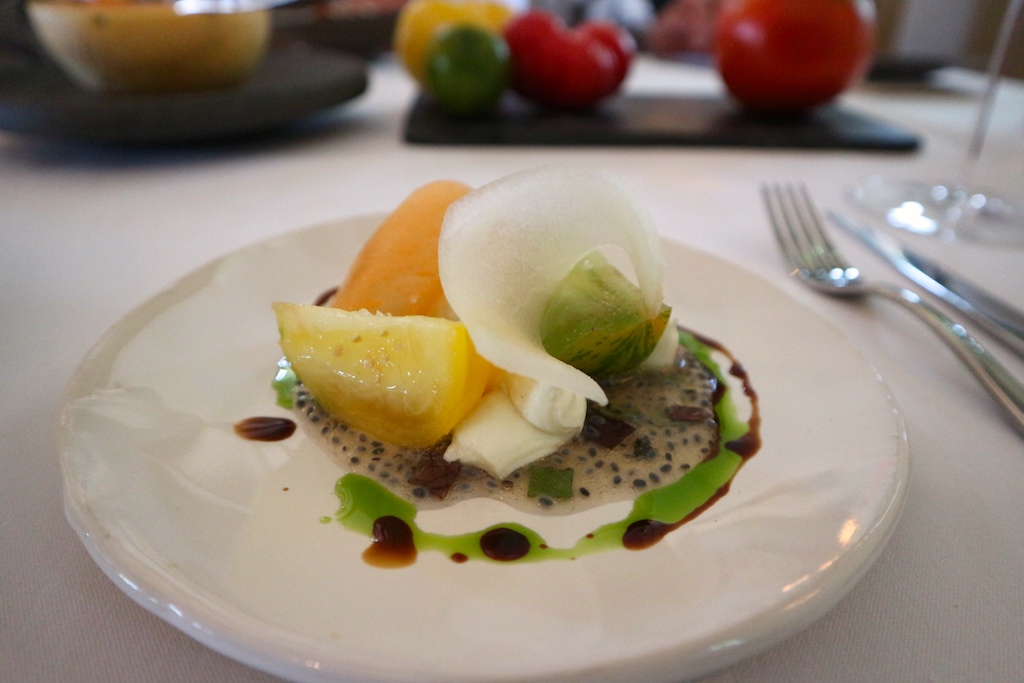

Eggplant followed. In Europe eggplant is often referred to as aubergine, but the magnificent presentation of the first two dishes urges me to use the word eggplant. A baby eggplant served in a chicken feet egg cup, was filled with a gorgeous mixture of spicy egg and soft eggplant and topped with caviar. Smoked eggplant puree topped with trout roe and eggplant foam was served in an eggshell. Finally there was a sliced, compressed and pickled, long green eggplant (choriku?), served with a horseradish cream dip. The compressing had given the eggplant an unusual but lovely texture, soft but still with a bite.
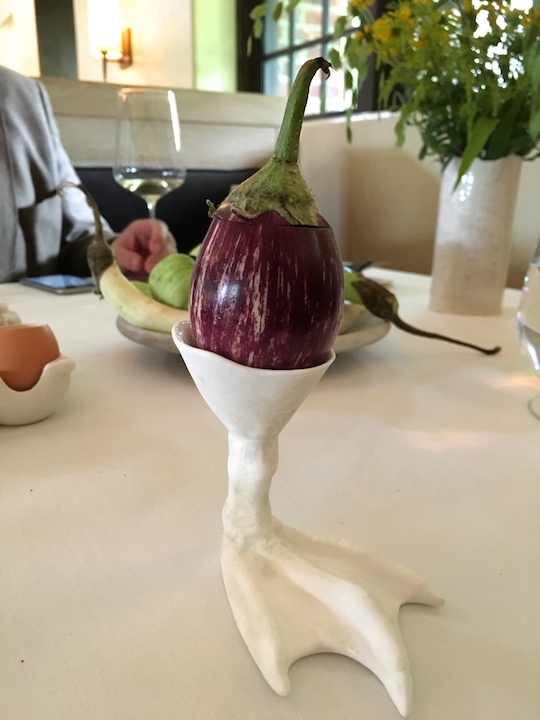
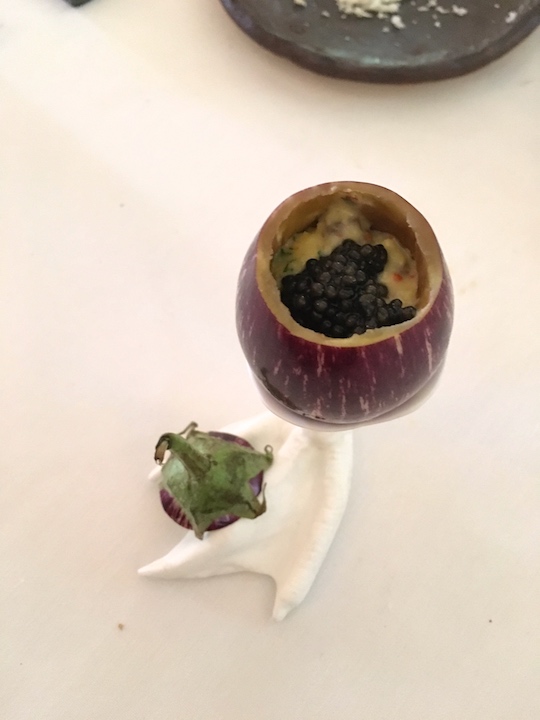
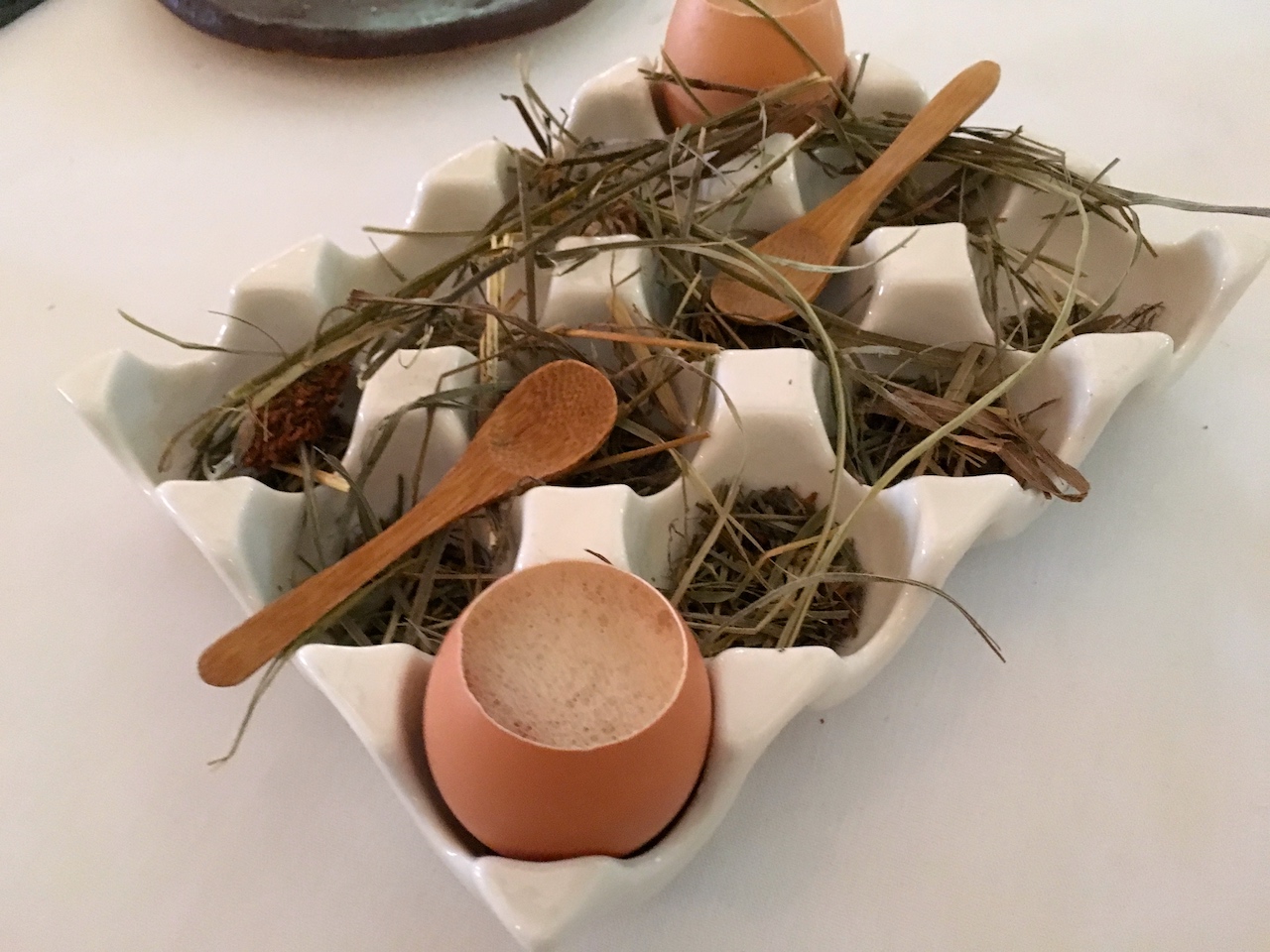
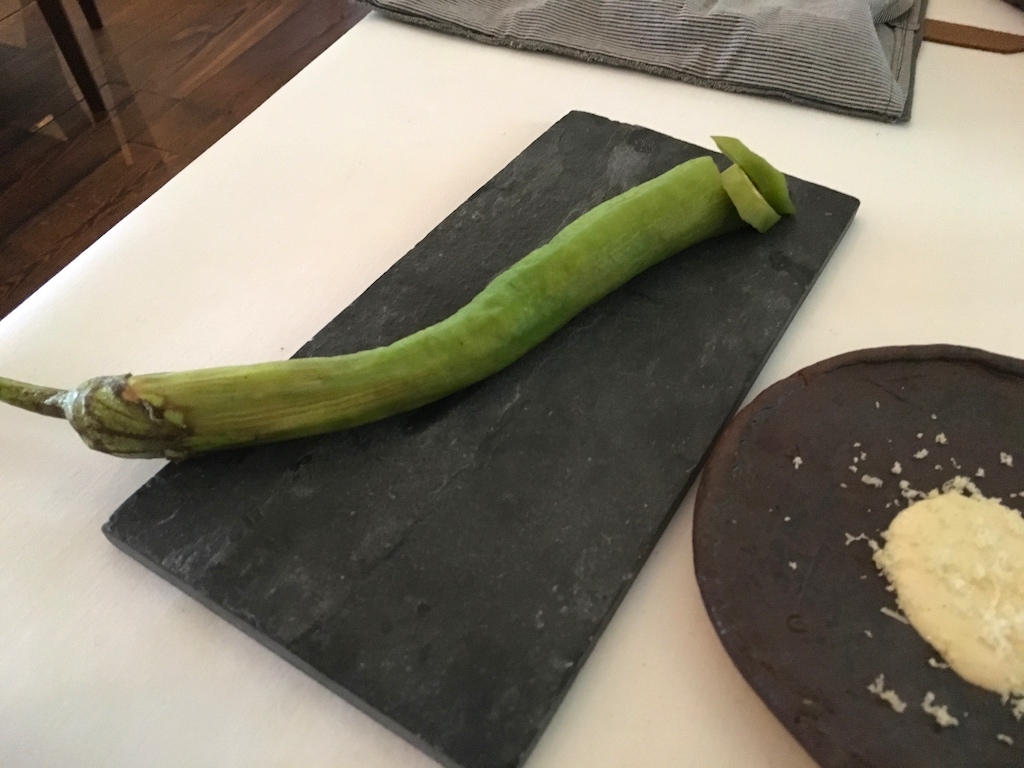

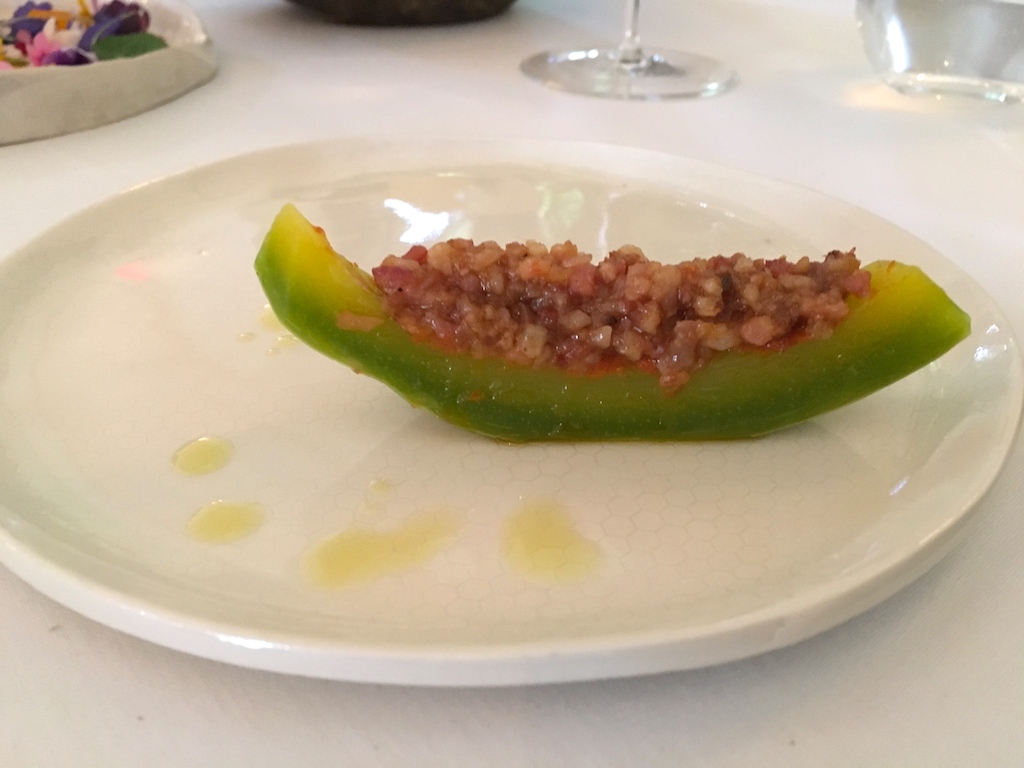

Corn took the spotlight in the next few courses. First up was a corn and lobster risotto. Two, or maybe even three types of corn were used for this risotto, the individual kernels being crunchy and offering a delicate sweetness but also some subtle nuttiness. With the risotto came the most remarkable sauce made with Cuitlacoche, a dark and unusual sauce, with a deep, penetrating umami flavour. Cuitlacoche is a type of black fungus found on maize and is also known as corn smut. In Mexico this fungus, known there as Huitlacoche, is considered a delicacy. I had read about corn smut being used in dishes, especially by American chef and corn expert Sean Brock, but this was the first time I experienced its terrific flavour and intensity. Both the corn and the corn smut were used to extraordinary effect here.
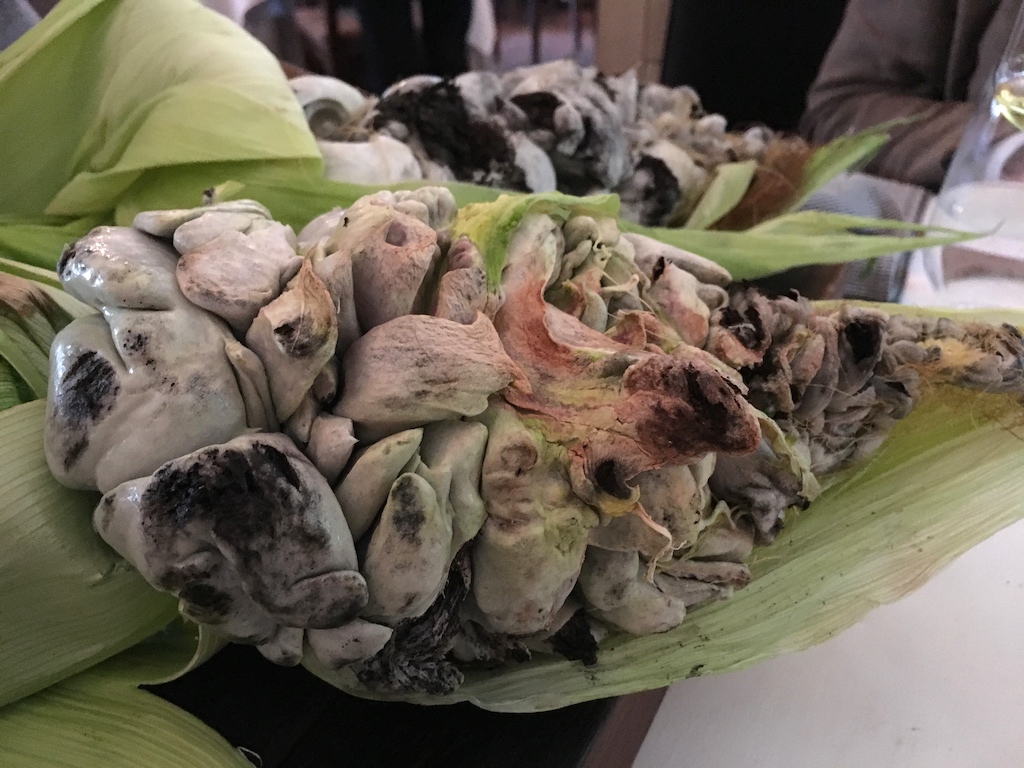
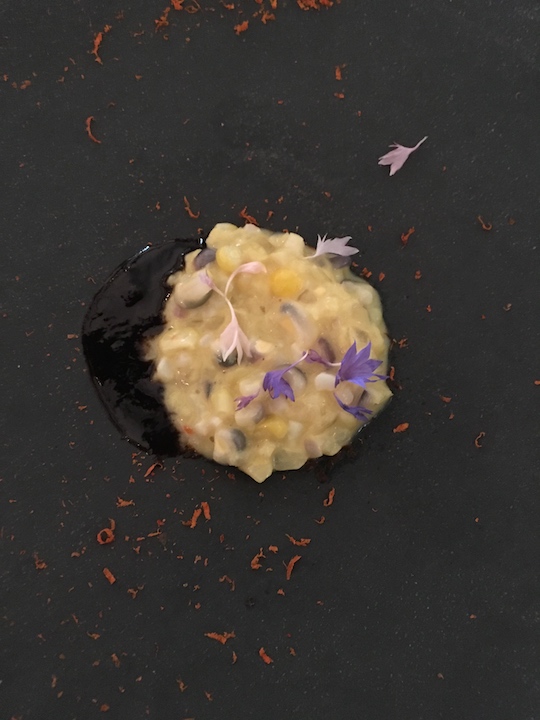
Alongside, there were baby corn cobs, coated with a smoky and peppery mixture, and yellow and white corn on the cob, steamed in their husk with lobster stock and seasoned with a sprinkling of dried chilli flakes, the yellow being my favourite, because its was incredibly juicy, sweet and flavoursome.
.
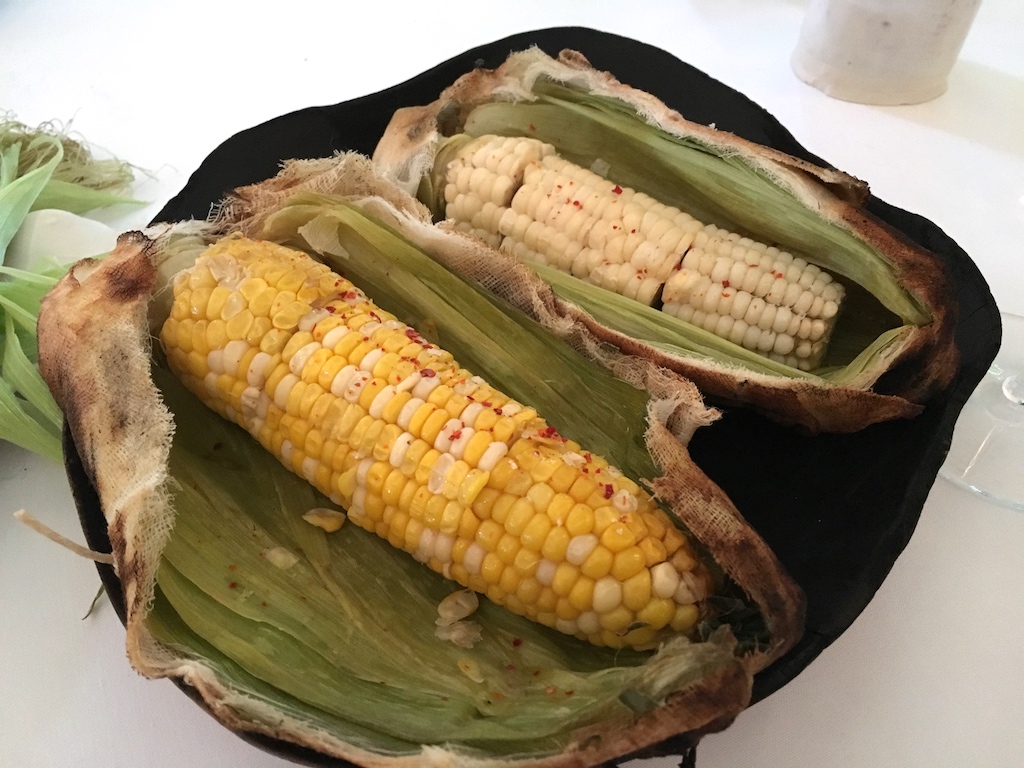
Altogether a rhapsody of corn that delivered surprise and delight, but most of all they showed the versatility of this humble and often overlooked and overworked ingredient.
For the next few courses we were guided to a shed behind the restaurant, but first we stopped at Blue Hill's bakery, where we got to meet Dan Barber and enjoyed a little tasting of bread made with (newly developed) wheats they have been experimenting with, including the "Barber Wheat". In the shed we were served three snacks/dishes. To start there was a potato-base pizza topped with the sweetest cherry tomatoes, mozzarella, and freshly grated egg, followed by some smoked and roasted artichoke hearts, classically paired with a bagna càuda dip, and various cooked potatoes, simply served with butter and salt. Three delicious snacks served in the most charming setting.
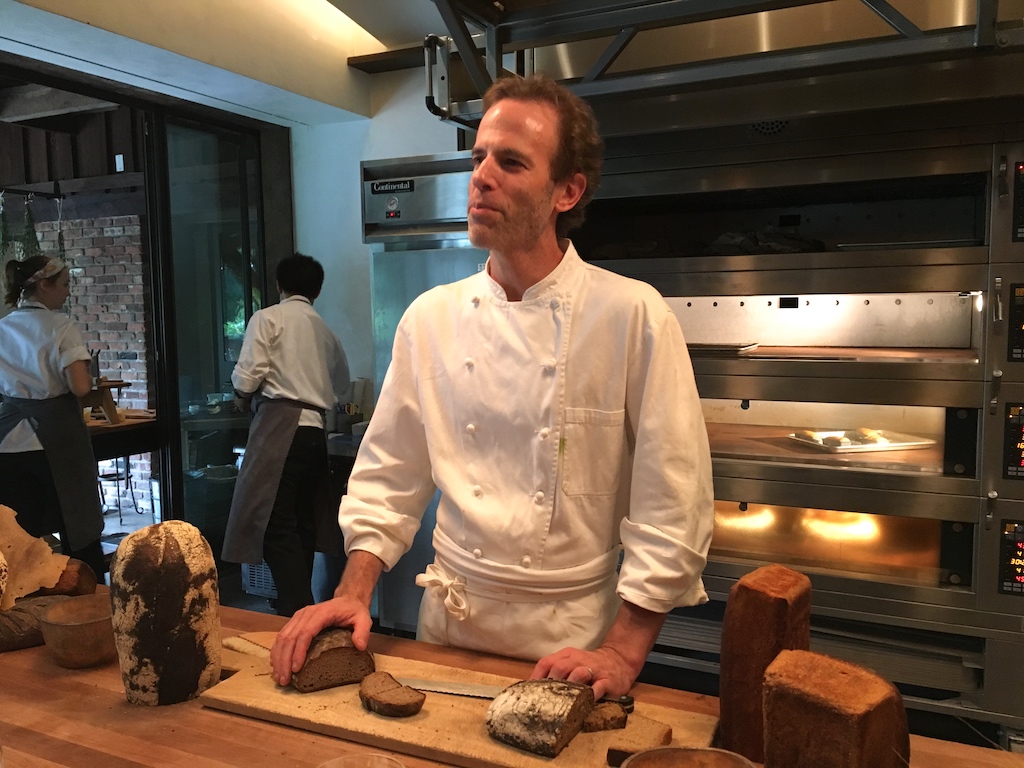
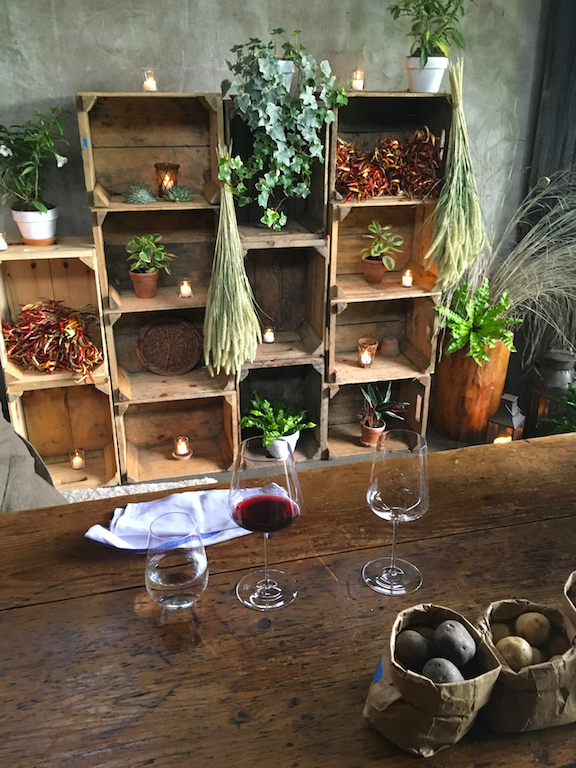

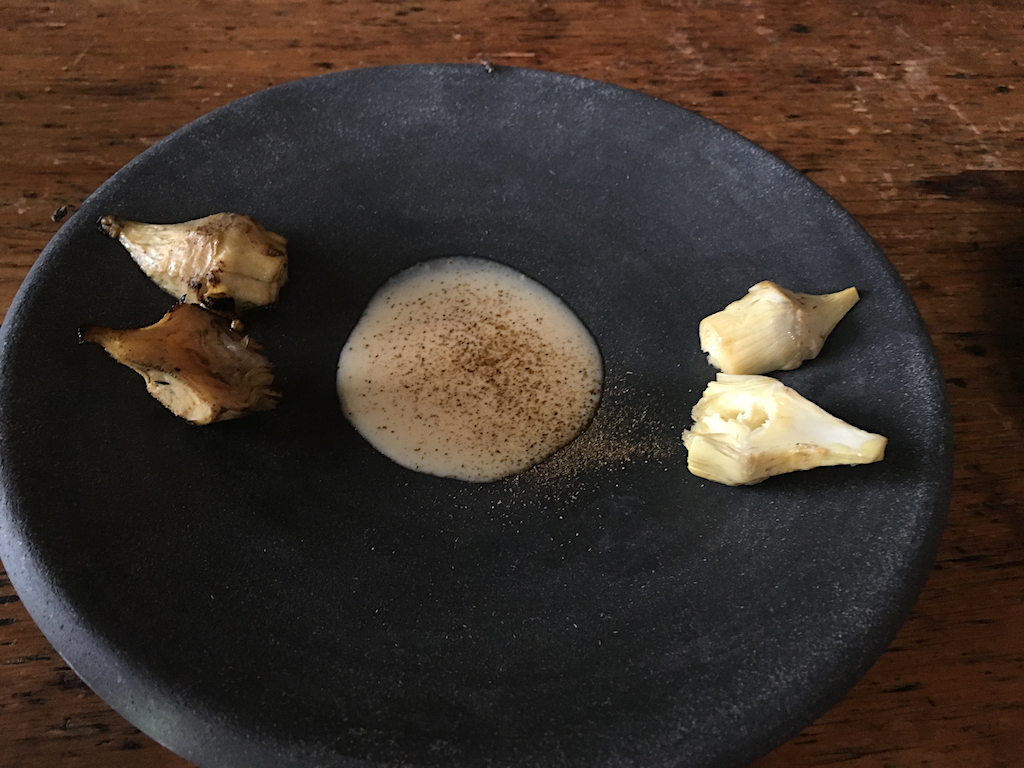
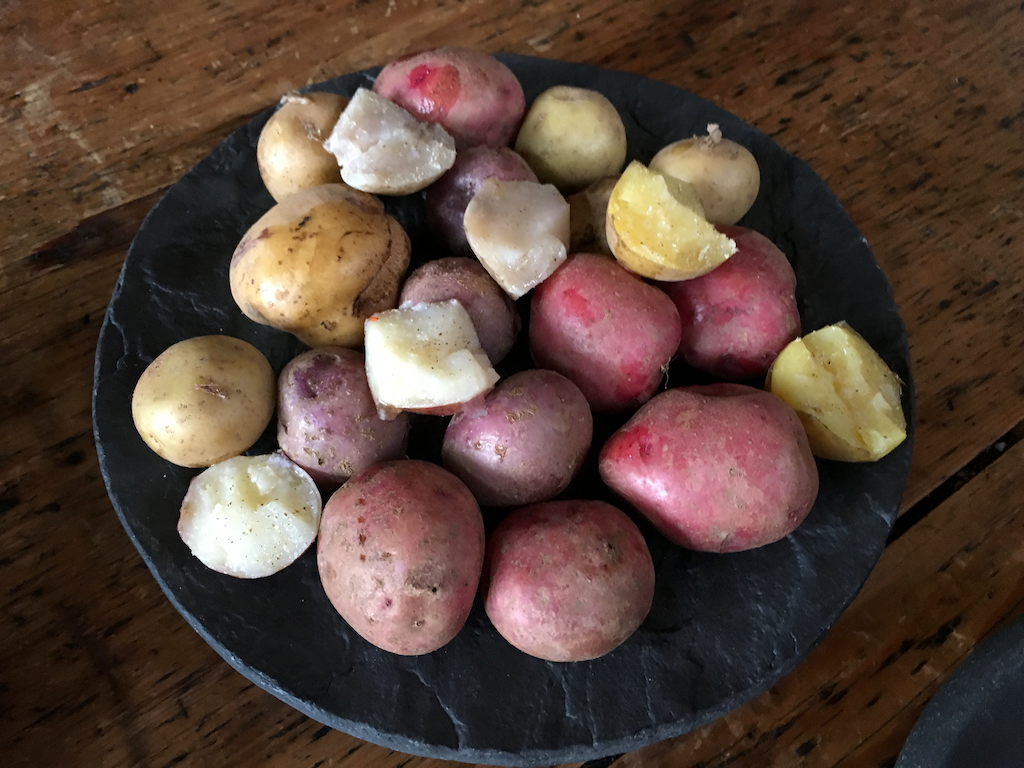
Back at the table, there was some Barber wheat bread served with single udder butter, in this case made with milk from Sunshine & Gillian.
The meat course today was roasted chicken breast (from the farm's own free-range chickens), cooked to ultra-succulent perfection, with wonderfully seasoned skin that had a lovely mellow spicy finish, and complemented by a satiny corn sauce and some concentrated chicken jus. Extra crunchy texture came from some sliced baby corn and squash. A humble but surprisingly indulgent dish and I was particularly struck by the staggering flavour of the chicken.

There was one more course before dessert. Tromboncino squash with a thin potato batter, served with shredded fermented onion, a thick and velvety yeasted potato sauce flavoured with a touch of cheese, and a side dish of veal bone marrow. The fermentation had given the onions a fantastic, lactic flavour, that combined wonderfully with the squash. A creative dish with very pleasing textures, and the bone marrow was a great sidekick.
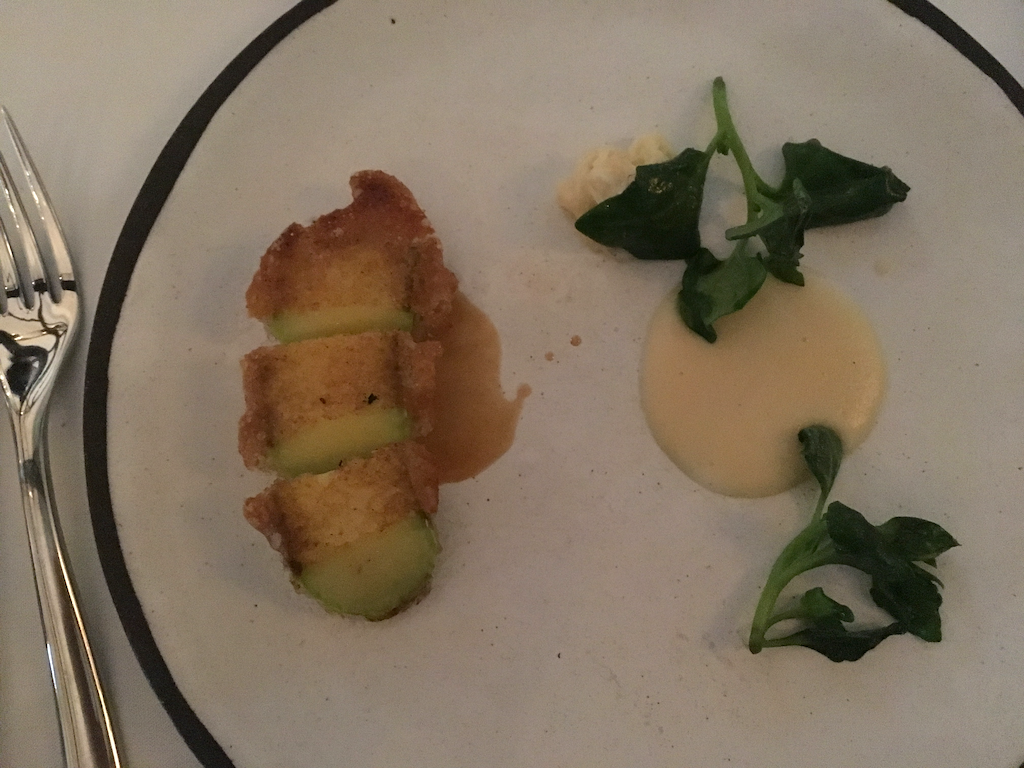
The dessert part of the meal started with some lovely goat's cheese and grilled melon. A dessert with various textures/preparations of condensed milk followed. There was condensed milk mousse, some condensed milk ice cream and condensed milk caramel (a bit like dulce de leche). Served on the side was a condensed milk "crepe". All this milky creaminess was accompanied by fresh strawberries with bee pollen, preserved blueberries, charred peaches, milk chocolate-coated honey comb and a slice of chocolate and cherry bread. The condensed milk trio was a very satisfying, not overly sweet combination, and the accompaniments brought lovely additional flavours and textures.
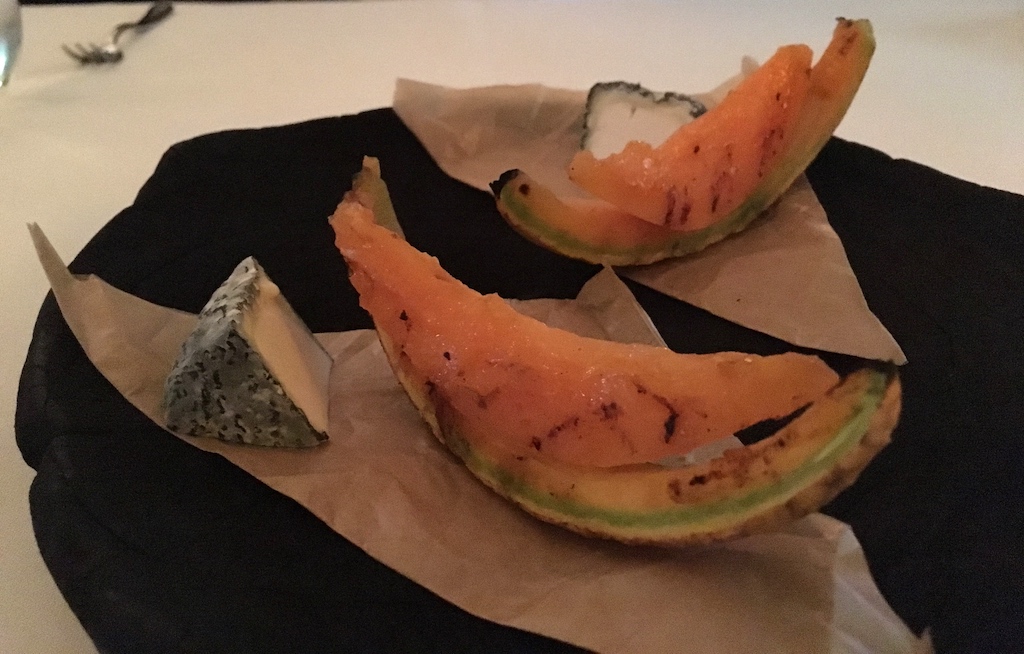

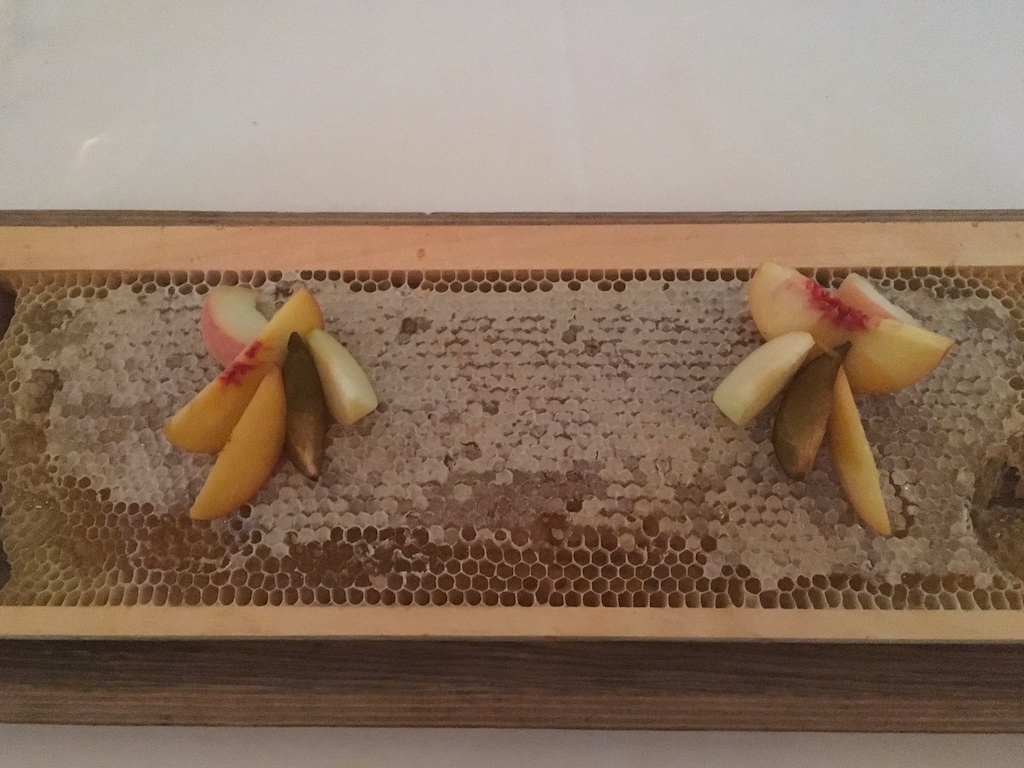
Some fresh stone fruit (peach, plum, nectarine) with fresh honey concluded this triumphant meal.
After the first few bites at the beginning of the meal, I instantly realised this meal was going to pull me out of my usual, haute cuisine, 'lobster, foie gras and Wagyu beef', comfort zone. Half an hour into the meal it became clear to me that this was haute cuisine too, vegetable cooking of the highest order. The menu, which had a good flow, also told a story, in an inspiring and pleasantly educational way, and was perfectly supported by the
warm and professional, but also extremely knowledgeable, front of house staff.
Dan Barber and his kitchen team treat vegetables with great intelligence and finesse, always trying to find the vegetable's perfect window of its life cycle. This results in a customised, vegetable-based menu, and they cleverly include moments of comfort by using warmth, texture or the moderate addition of fish or meat. The farm is an integral part of the restaurant and at Blue Hill they work with what's available that day, but their library of ingredients and knowledge seems to be unending. Come back a week later and you could be served a completely different menu. A meal at Blue Hill is more than just a memorable experience, it's an all-consuming, (in my case, including the tour, 5-hour) experience, during which you try to soak up as much knowledge as you can, because the cuisine at Blue Hill is the embodiment of food for thought.
There's no comment section on this website, but please feel free to contact me through Twitter (@ElizabethOnFood) or Facebook (ElizabethOnFood).













